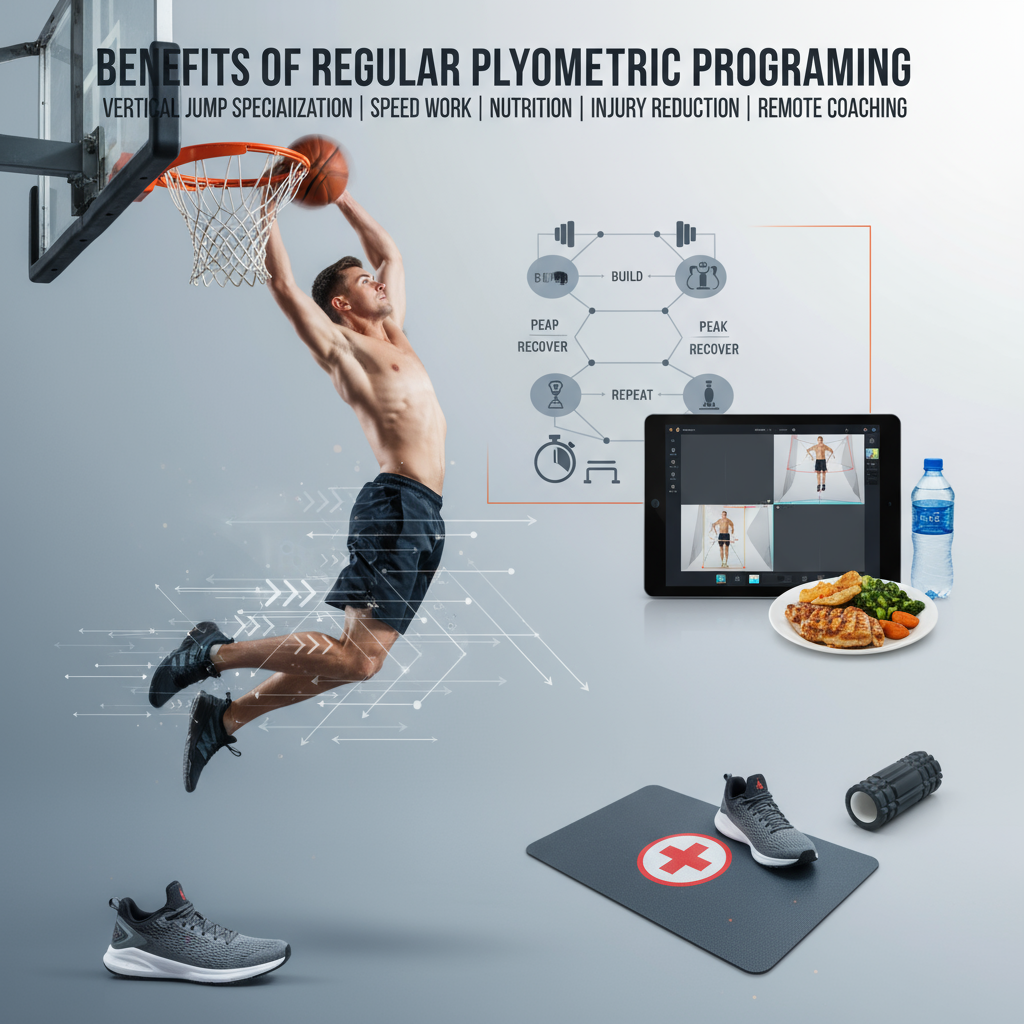For athletes, coaches, and serious weekend warriors who want a higher vertical but keep getting stuck — frustrated by plateaus, nagging aches, or inconsistent performance — this guide shows why a holistic training plan fixes those problems instead of masking them. Our coaches blend strength, mobility, nutrition, recovery, and mental skills into practical programs that improve your vertical jump and protect your body, so you can perform longer, recover faster, and jump higher without feeling burned out.
Top 9 Benefits of a Holistic Approach to Vertical Jump Training
So here's the thing about chasing a bigger vertical — focusing on one drill won't cut it. A holistic approach treats the whole athlete, not just the legs. Below are nine clear benefits, and how to get them.
1. Bigger explosive power because you're training the whole force chain
Power aren't just about squatting heavy. It's about connecting hips, core, shoulders, and ankles so force transfers efficiently into the jump. Holistic programs mix strength, Olympic-style pulls, and fast plyometrics to create force production and rate of force development.
How to apply it: add 2 heavy strength sessions per week (focus: hip hinge, squat, and loaded jump variations) and 2 focused plyo sessions per week (low-contact depth jumps, weighted jump squats with light loads). Keep plyo volume low and quality high.
2. Faster recovery and less chronic fatigue
Recovery is training. If you're grinding and not recovering, your CNS and muscles don't adapt. Holistic training includes sleep coaching, targeted nutrition, scheduled active recovery, and manual/recovery modalities (foam roll, massage, contrast baths) so you actually get stronger between sessions. Learn more about targeted nutrition.
Action step: aim for 8 hours of sleep nightly, add one full active recovery day per week (light bike or swim, mobility), and use 10 minutes of targeted soft-tissue work after workouts.
3. Reduced injury risk through balanced movement and load management
In my experience, athletes who only do heavy squats or endless box jumps often end up with knee, Achilles, or low-back problems. A holistic plan builds resiliency: eccentric control, single-leg strength, mobility, and progressive loading — they all lower injury risk by creating durable tissues and smarter movement patterns.
Tip: include one unilateral strength exercise each session (split squat, single-leg RDL) and monitor load with a simple 1-10 soreness scale — if you're above 6 the next day, back off volume.
4. Better technique and body awareness (so power actually transfers)
Strength without coordination is wasted. Holistic training trains technique under fatigue, motor control drills, and active mobility so you don't lose your jump mechanics when the game heats up.
Quick drill: 5 minutes of rebound jumps focusing on soft landings and hip-drive, then 5 practice approaches at 70 percent intensity. Short, specific reps beat mindless volume.
5. More consistent performance — you peak when you need to
Consistency comes from planning: periodized workloads, tapering, and recovery windows. A holistic approach treats performance as a timeline, not a one-off sprint, so you're hitting PRs during games and tests, not during random training days.
Practical plan: build 3-week microcycles with gradual load increases for 2 cycles, then a deload week. It keeps progress steady and prevents burnout.
6. Sustainable long-term gains instead of quick spikes
I think of holistics as the compound interest of training. Quick spike programs get results fast, but they crash. Building mobility, tendon strength, and movement efficiency yields gains you keep for years, not weeks.
Long-term move: prioritize tendon-loaded eccentrics once per week (slow step-downs, slow RDLs) to build durable connective tissue.
7. Optimized nutrition that fuels performance and recovery
Nutrition is performance. If you skip it, you're undercutting strength, recovery, and the ability to generate power. Holistic programs use macronutrient timing, protein targets, and hydration strategies so energy systems are primed and tissues recover.
Simple rules: eat 30 grams of protein within 45 minutes post-workout, consume 400 calories of carbs before heavy sessions, and sip 500 milliliters of water 30 minutes before training. Small, specific moves add up.
8. Stronger mental toughness and focus under pressure
Mental skills are often ignored, but they separate good jumpers from great ones. Breathing drills, visualization, and short pre-performance routines improve confidence and reduce performance anxiety — especially in clutch moments.
Practice: 3-minute breathwork session before practice starts, and a 30-second visualization of your approach and landing before each competitive jump. Trust me, it works.
9. Improved athlete wellness and longevity
Holistic work isn't just about higher numbers — it's about staying healthy, enjoying the sport, and playing longer. Better sleep, balanced hormones, and reduced pain mean you're not only jumping higher, but you're also present for more seasons.
Team move: schedule regular wellness check-ins every 8 weeks (mobility screen, load review, nutrition check). This prevents small issues from becoming season-ending problems.
How to build a simple holistic vertical jump program (what to actually do)
Look, you don't need to reinvent the wheel. Start with structure, then tweak for your sport and schedule. Below is a straightforward weekly template you can adapt.

- Monday - Strength day: heavy squats, Romanian deadlifts, core anti-rotation work (3 sets of 4-6 reps for main lifts)
- Tuesday - Plyos: low-volume, high-quality jumps, approach jumps, and landing mechanics (6-12 total contacts)
- Wednesday - Active recovery: mobility flow, 20-minute bike, soft tissue work
- Thursday - Strength-speed day: Olympic pull variations or trap bar jumps, single-leg strength (3 sets of 3-5 reps)
- Friday - Conditioning and technique: short sprints, approach drills, mental rehearsal
- Saturday - Optional skill day or light plyos, low intensity
- Sunday - Full rest
Progression: increase load or intensity every 2 weeks, then take a deload week on week 7. Keep volume controlled. You're building quality, not just quantity.
Common mistakes to avoid
So many athletes try to shortcut this. The top mistakes I've seen:

- Only doing bodyweight plyometrics without strength work - strength is your engine
- Chasing volume instead of technique - lots of bad reps cement bad movement
- Neglecting sleep and nutrition - you can't out-train poor recovery
- Ignoring unilateral work - single-leg strength equals stability and injury prevention
Don't make those mistakes. Fixing one of them often buys you more improvement than adding another drill to your routine.
If this feels overwhelming, we can help
Designing a holistic plan that fits your schedule and sport is the tricky part. Our coaches run a simple process: assess movement, set 3 clear performance goals, build a 12-week block, then monitor progress every 4 weeks. If you want help, our team can create a personalized program and handle the adjustments so you stay on track.
Frequently Asked Questions
How long until I see improvements in my vertical jump?
Short answer: you can see small improvements in 4 weeks and more meaningful gains in 8 to 12 weeks if you train consistently and manage recovery. Why? Strength and neuromuscular adaptations start quickly, but tissue resilience and refined technique take longer.
Can nutrition alone increase my vertical jump?
No. Nutrition is essential, but it's a support system. Proper fueling and protein help you recover and build muscle, which allows your training program to be effective. Think of nutrition as the fuel and repairs while training is the stimulus.
Should I lift heavy or do more plyometrics?
Both. Heavy lifting builds the force capacity, while plyometrics trains the speed of force application. Combine them across the week — heavy strength 2 times and focused plyo 2 times is a strong starting point.
How do I prevent injuries while trying to jump higher?
Prevent injuries by including unilateral strength, eccentric loading, mobility work, and planned deloads. Also, monitor pain and soreness — if you're consistently above a 6 on a 1-10 scale the next day, reduce volume and prioritize recovery.
Will mental training really help my vertical?
Yes. Stress and anxiety disrupt coordination and timing. Short routines like breathwork, visualization, and cue words help you execute with more confidence and cleaner technique under pressure.






